Let’s get right to the point, I’ve been a fan of the sencha brand, Mellow Monk, for years.
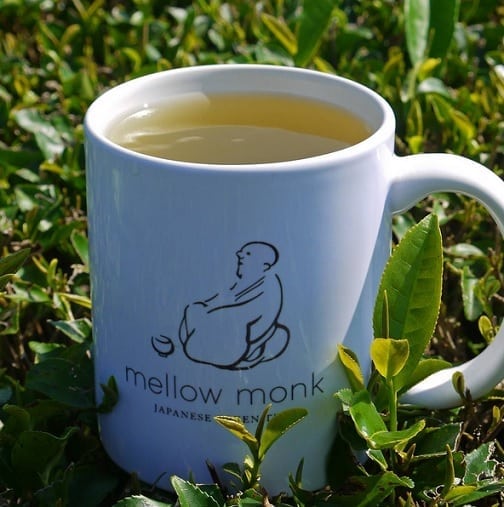
Pretty much since the early days of my tea blogging career. The only one who seemed unaware of this, however . . . was Mellow Monk.
They first popped up on my radar as early as (I think?) late-2010. The reason? They primarily dealt with farmers located in Kumamoto prefecture, situated in the far southernmost Japanese island of Kyushu. Tea farmers in the region made my favorite style of sencha: tamaryokucha (or guricha, depending on how lazy you felt). Instead of the usual “spider legs” shape of machine-cut green tea, tamaryokucha’s leaf-cuttings were allowed to “curl” (or “tama”) during processing. Hence the name: tama (“curly”), ryoku (“green”), cha (“tea”).
I loved the stuff, but I’ll confess I knew very little about the region or those who tilled the land. For instance, did you all know that Kumamoto literally translates to “Land of Bears”?
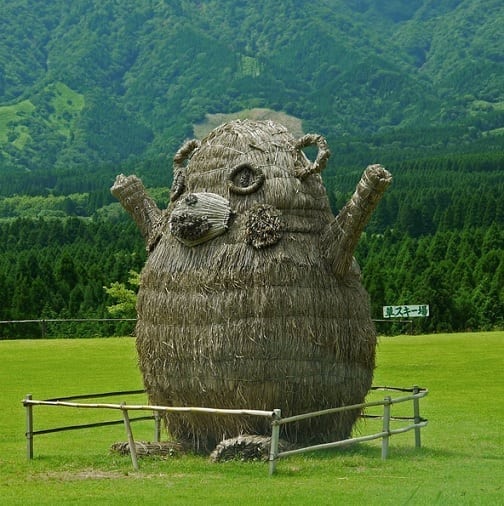
I had no idea, either.
Mellow Monk contacted me several months ago to cover some of their wares. Little did they know, but I had tried nearly all of their teas. However, to give them the benefit of the doubt, I perused their products list to see if there was anything I hadn’t sampled, yet. It turned out there were two items on the list. And they were made by one farmer.
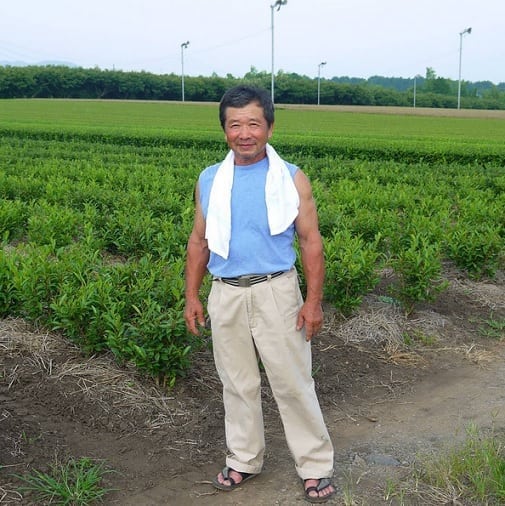
This badass is Kazuo Watanabe.
His estate is located near the village of Sagara, situated in the Kuma district . . . of Kumamoto. So, yeah, he’s from a village in the BEAR district of the LAND OF BEARS prefecture. I love you, Japan. Don’t ever change. Anyway . . .
Mr. Watanabe has decades of tea-growing and tea processing experience, and his teas have picked up several awards since the 1990s. Mellow Monk even did a featurette on him in a documentary about their tea-buying trip:
From Mellow Monk’s tea roster, I’d only tried one of his teas; Mountain Snow, a powdered tamaryokucha. That wasn’t even sent to me as a sample. I bought it outright without even trying it first. If memory served me well, I liked it quite a bit. After our initial discussion, Mellow Monk told me that the “Kazuo Kit” was on its way to me.
Heh . . . Kazuo Kit, I gotta kick outta that.
The day I received the “Kazuo Kit”, I immediately dove into the powdered sencha offering. Yes, that’s what it is—powdered sencha. To call it regular matcha would be misleading. Guricha-style green tea leaves are the base for the powder, not de-veined gyokruo; which is a cornerstone for matcha. I reviewed it years ago for another site, but I was quite excited to revisit it. I immediately did a whisk up that afternoon.
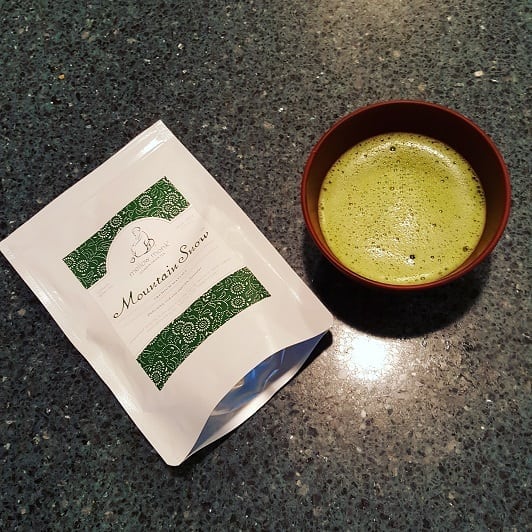
And I was completely surprised by the pure umami punch to the tongue this stuff delivered. Not to say it was a bad time, I was just used to soft, blankety matcha. This wasn’t that. Perhaps I needed to obey the brewing instructions to the letter.
The brewing instructions were markedly different than I remembered. Instead of prepping with 160F water, Mellow Monk recommended boiled water. And instead of two chashaku spoonfuls of powder, which equated to almost half a teaspoon, they recommended only one. Or rather, close to one; ¼ teaspoon, to be more precise(-ish)—a little over 1 gram of powder.
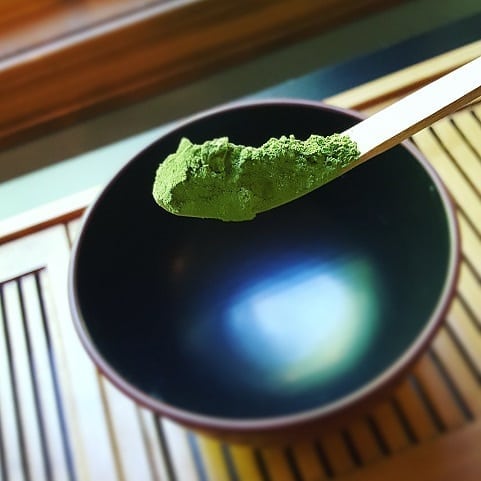
I went with that . . . and hoped for the best.
The green tea powder itself smelled woooonderful, but not like matcha. The tried-‘n-true matcha powder has a distinct—well—matcha smell; silken blankets, blossoms, grass, forest, sweet desserts. That kinda thing. This smelled more like cooking grade matcha, but with more of a green tea bend. Not grassy; just more green tea-ish. Umami was strong on the nose, along with a sweetened nuts vibe. The color was also a shade darker green, not bright matcha green. Deeper, more resolute.
Even with the entirely different instructions, the “matcha” brewed up about the same.
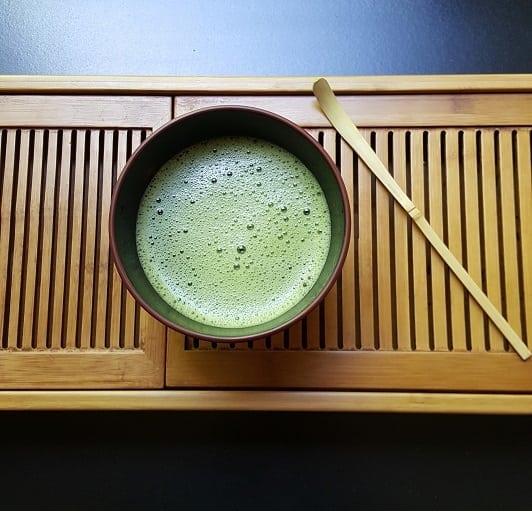
The froth wasn’t as thick, but there was still plenty of bubbly action. On first sip, mild, smooth sencha green goodness hit the tongue first. Some fruits and dates showed up in the middle. The finish was all tempered umami and spring grass. And I’m pretty sure I detected a shade of “green tea chocolate bar” notes at the very end. Far different an experience than, say, Uji matcha, but a worthwhile beast all its own.
Several years later, I’m happy to see that it still holds up. And now that I know how to brew it correctly, I’m enjoying it even more. I’m all misty-eyed and nostalgic just thinking about it, and the taste lingers just as long.
As mentioned above, I was familiar with guricha/tamaryokucha style sencha. And this looked like many of the others I had tried, except maybe with a smaller leaf cut. That said, the leaves that were there were still curly, needle-like reeds, and not the “spider leg”-y sencha of other regions. The smell they gave off was very sencha like; strong on the grassy notes, but with the added benefit of nuts and fruit to the aromatics. There was also a lingering sweetness to the scent, which I liked.
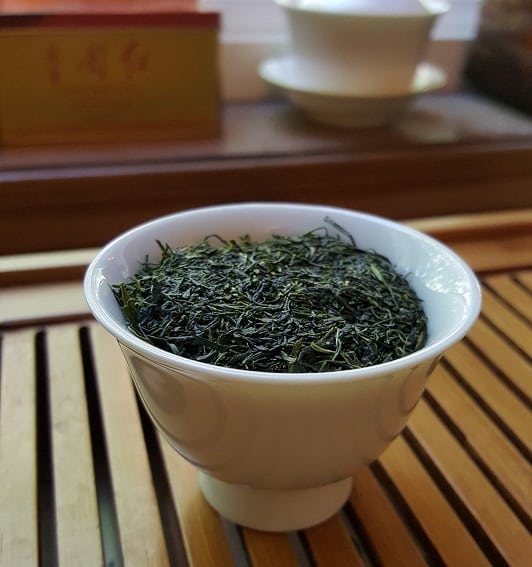
I used my one Japanese tea pot to brew up roughly 1 tsp. of leaf to 6-8oz. of 165F water. After that, I adhered to the recommended two-minute brew time cap. That seemed longer than usual, but I found Mellow Monk’s recommendations to be sound. Especially after the surprise with the Mountain Snow.
The liquor brewed bright, radioactive green—as was typical with just about any sencha. The aroma from the cup was all garden grove, freshly-mowed Sunday afternoon suburban lawn, and something . . . vanilla-nutty. Huh . . . wasn’t expecting that.
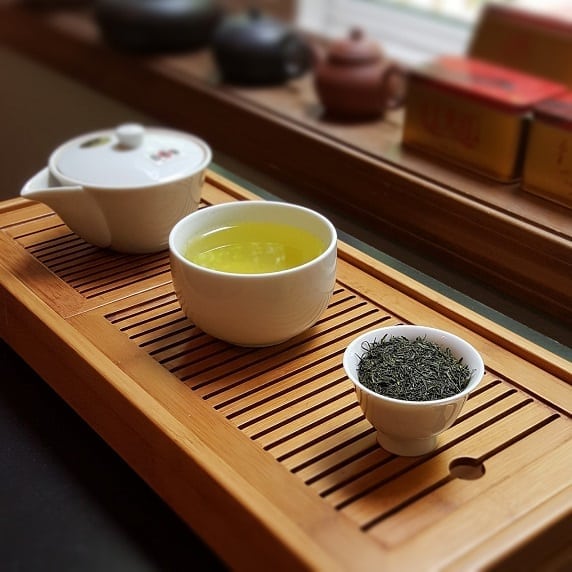
As for taste, it was really strong on the grass and umami bit. Too strong, even. That made me think that perhaps the two-minute brew time was a little strong. Sure, it made for a great “farmer-style” burly brew, but that’s not what I was looking for.
A second infusion, at an indeterminate brew time—somehow—turned up a stronger, brothier . . . and absolutely perfect brew. All grass and citrus fruit. No idea how to explain that.
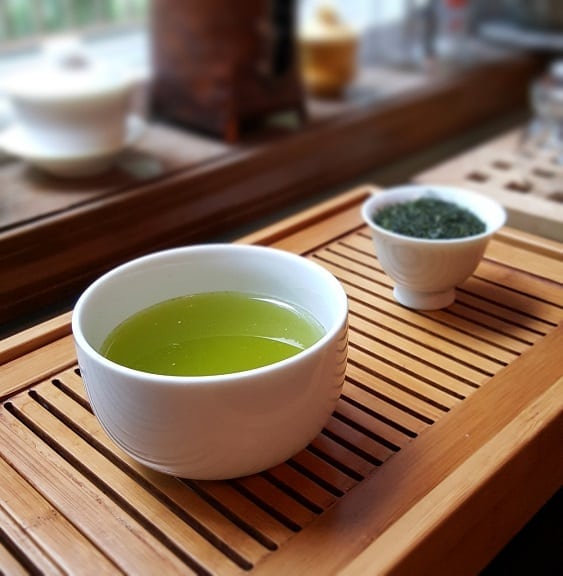
However, I did know I had to give it a second go.
I went at it again with a new set of leaves. The old ones were burnt to hell, and pretty well spent. This time, though, I dialed the brew time down to a minute. Standard for a sencha.
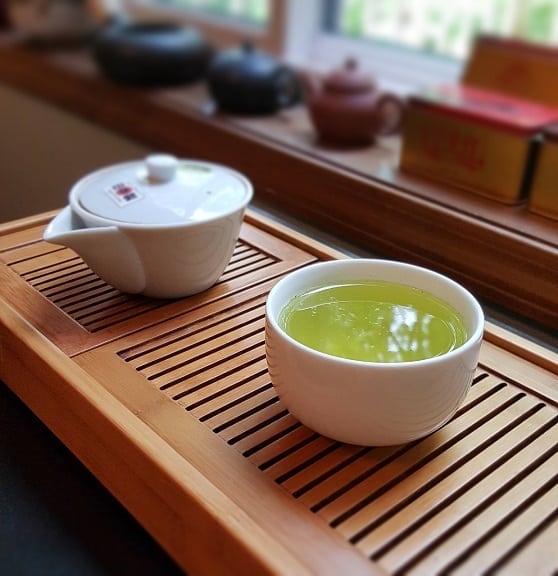
The results were perfection, in just about every way. The intro was only slightly grassy, and then immediately transitioned into green tea–flavored vanilla silk . . . cream. The sensation was equal parts taste and texture; there was no distinguishing between the two.
When I finally got to this offering, I must admit . . . I was initially disheartened. They were teabags. In recent years, I’ve come to view teabags with a little bit of ire. No longer did I apologize for their existence. They were the one “innovation” that was (literally!) holding loose tea leaves back. However, with a deep sigh, I examined it . . . and quickly tore open the bag with a pair of scissors.

The contents were small-cut, fannings grade roasted sencha. Not to be confused with houjicha, which was comprised of leaves and stems; this was all leaf. Well, small leaf, anyway. I could see why they were bagged, now. I didn’t like the reason, but I could see it. The whole point was to have more leaf per surface area, and a mesh to prevent leaf particles from escaping. The end goal: a perfect delivery system for cold-brewed tea, for which this was intended.
Well, I chose not to abide by that design, and brewed it up hot. Boiling, even.

I took a teaspoon of fanned leaves, and brewed them up in my trusty houhin teapot. Leaf matter still somehow escaped through the pot filter, but not enough to be a nuisance. The resulting brew was . . . pleasant. Roasty, toasty, sweet and strong! This was one helluva heavy-bodied roasted sencha. Again, probably because of the leaf cut.
On another occasion, I took one of the whole bags and put it in my travel mug.
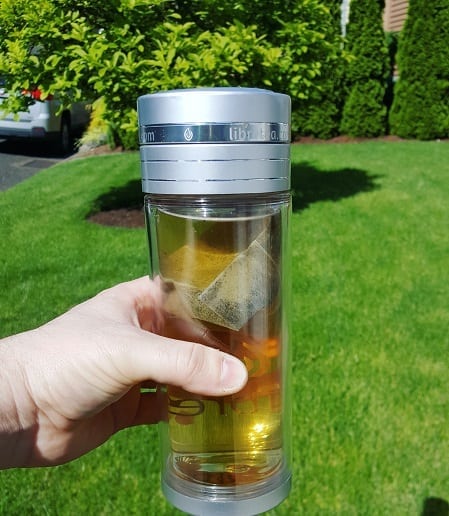
The amount of leaf in the bag was meant for a 32oz. cold-brew. My tea tumbler only carried 14oz. This would be interesting.
Honestly, though, I found it perfect. All the roasty-toasty-sweet goodness showed through in the brew, and—even stranger still—it held up to an hour-long steep. Some folks on Instagram cringed at that fact, but who cares?
A few weeks later, I decided to finally brew it up properly. As in, a cold-brew. I wasn’t a fan of most cold-brewed teas, especially the ones I made myself. I could never get it right. Iced tea was more my thing. But, given that this was designed for that purpose, I gave it the benefit of doubt.
Small problem, though. I didn’t have a 32oz. pitcher for the brew-up. All I had was a 16oz. plastic mug . . . with a straw. It even had my name on it.
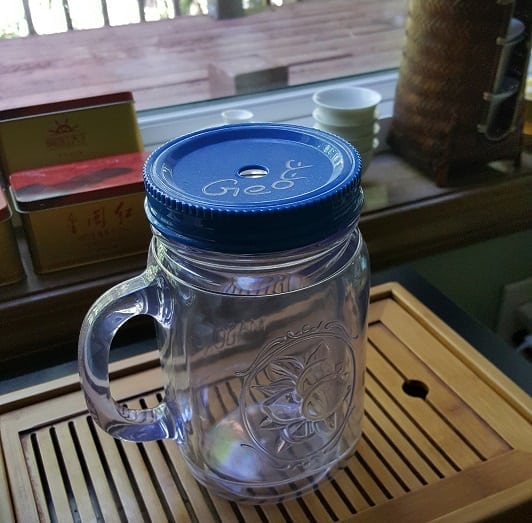
Whatever . . . I prepped it anyway. I even ductaped the straw hole.
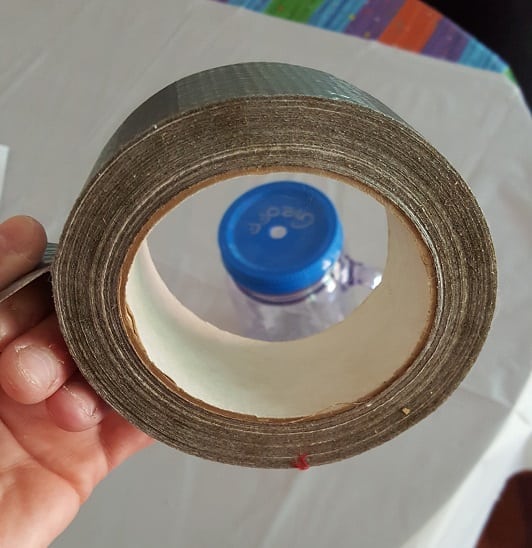
Soon after, I plopped the bag in, filled it with room temp water, and stuck it in the fridge. Optimally, Mellow Monk said to pull it out after three-to-four hours. I . . . er . . . forgot about it until Hour Number Five. Oops.
That evening, I pulled it out and gave it a good shake, per the brewing instructions. I was shocked to discover that a layer of beer-like froth developed after said shaky-shaky. Seriously, it looked like a lager.
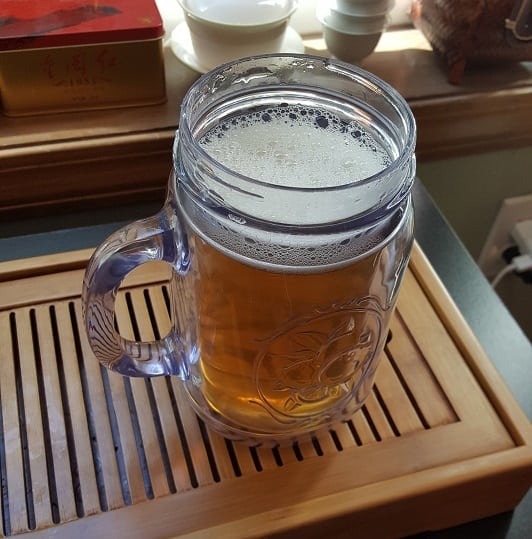
Luckily, it didn’t taste like one. All the pleasant roasty-toasty-sweet notes were there, perfectly intact—only cooler. Almost dangerously pleasant in hot weather; like having a beer during a backyard barbeque.
Wow, this simple blog went insanely long. I guess I had more to say about these teas than I thought. Gotta hand it to good ol’ Kazuo Watanabe, he knows how to play with tea leaves in unique ways. From tamryokucha, to powdered sencha, to cold-brewed roasted green tea, there’s quite a bit of versatility to his “kit” of teas.
A wide range of flavors . . . from the Land of Bears.
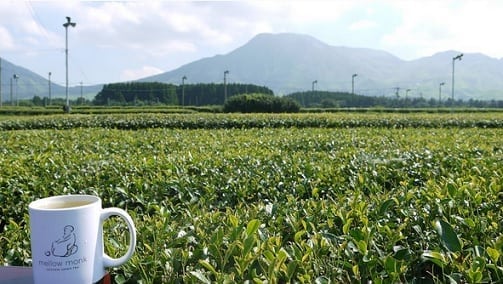
To buy Mountain Snow, go HERE.
To buy Kuma Green, go HERE.
To buy Kumagawa, go HERE.
Leave a Reply to Lord Devotea Cancel reply